ST-2000XM
Product Improvement
Announcement
Updated: January 7, 2005
![]() The ST-2000XM and ST-2000XCM cameras now use the latest KAI-2020M and
KAI-2020CM CCD from Kodak. This new CCD has 1.8X lower read noise, 10X fewer bright
points, and 2X lower dark current than the former KAI-2001M. It is used in both the
monochrome and single shot color version of the ST-2000XM camera. Other enhancements
in 2004 include the addition of a custom Pelican Carrying case, EquinoX software for the
Mac, and TheSky Version 5.
The ST-2000XM and ST-2000XCM cameras now use the latest KAI-2020M and
KAI-2020CM CCD from Kodak. This new CCD has 1.8X lower read noise, 10X fewer bright
points, and 2X lower dark current than the former KAI-2001M. It is used in both the
monochrome and single shot color version of the ST-2000XM camera. Other enhancements
in 2004 include the addition of a custom Pelican Carrying case, EquinoX software for the
Mac, and TheSky Version 5.
In July, 2004, Kodak introduced the new KAI-2020M CCD. This latest version of the 2 megapixel CCD retains the improved QE of the KAI-2001M and adds a high gain output amplifier that reduces the read noise by almost half compared to the previous CCD. In addition to lower read noise, the bright points have been reduced by a factor of ~10X and our tests show the typical dark current is also reduced by approximately 2Xcompared to the previous versions of the CCD. These same improvements are also found in the single shot color version of the CCD used in the ST-2000XCM color camera as of July, 2004 (All ST-2000 monochrome and color cameras beginning with serial number 20407000 or higher).
Previously, Kodak improved the Quantum Efficiency of the 2000 series CCD when it upgraded the KAI-2000M to the KAI-2001M. This higher higher QE is retained in the new KAI-2020M, with approximately 25% to 40% higher QE (10% to 15% absolute) across the visible spectrum than the former KAI-2000M. Also, In August, 2003, we switched to the larger TC-237H built-in guiding CCD instead of the TC-211. This improvement was the same as the upgraded autoguider installed on the larger ST-8XE, ST-9XE and ST-10XE cameras.
In addition to the new CCD, in May of 2004 SBIG began including a custom Pelican carrying and storage case with the ST-2000XM and ST-2000XCM models. This case is dustproof, waterproof and crushproof and carries a lifetime guarantee from Pelican. As of the date of this announcement, we are also upgrading the version of TheSky software by Software Bisque that we include with the ST-2000XM camera from version 4 to version 5, a $129 value. If you have a Macintosh computer running OS-X we will even throw in Equinox camera control and planetarium softwaref or the Mac as well! We continue to include CCDSoftV5 in addition to CCDOPS version 5 the most complete package of camera control, image processing, astrometric, star charting and planetarium software available with any new CCD camera from any manufacturer. Upgrades are available for most of these improvements for older ST-2000XM camera owners.
Improved Read Noise and Dark Current
| Parameter | KAI-2000M KAI-2001M |
KAI-2020M |
| Typical Read Noise (rms) average | 13.5 e- | 7.6 e- |
| Typical Dark Current (average e-/p/s at 0 deg. C ) | 0.18 e- | 0.06 e- |
| Typical Dark Current in the top 1% of pixels | 2.5 e- | 1.1 e- |
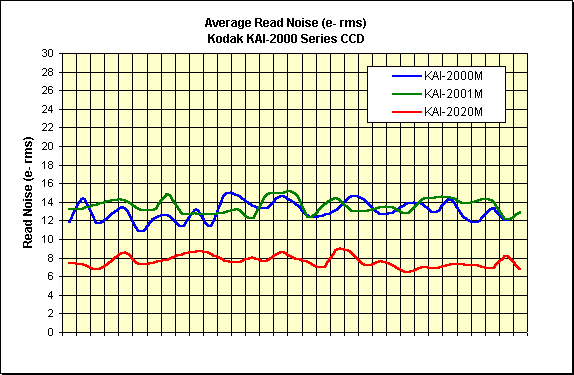 |
The average read noise has been reduced by almost half in the new KAI-2020M CCD. Previous KAI-2000 series CCDs tested just under 14e- rms but the new KAI-2020M typically measures less than 8e-.
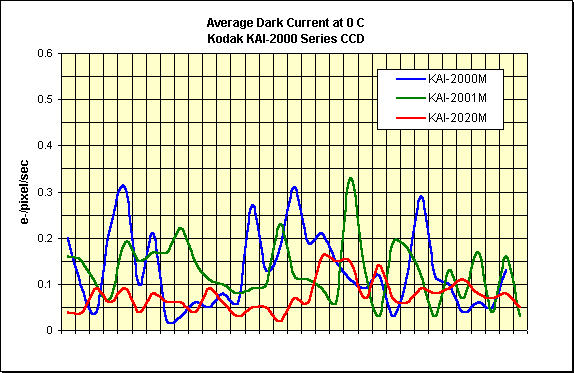 |
Measurements made of a number of cameras show that the previous CCDs had an average dark current of 0.13e- and 0.18e- for the KAI-2000M and KAI-2001M respectively. Tests of a similar sampling of cameras made with the new KAI-2020M CCD show an average dark current of 0.06e-.
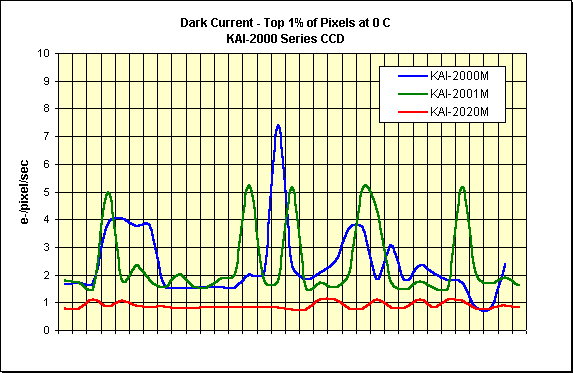 |
Measurements of the dark current in the top 1% of pixels shows a dramatic improvement. The previous detectors measured showed an average dark current in these pixels of around 2.5e- whereas the KAI-2020M measures on average only about 1.1e-.
The lower read noise, lower dark current and reduced bright points (see below) combine to significantly enhance the performance of this new CCD.
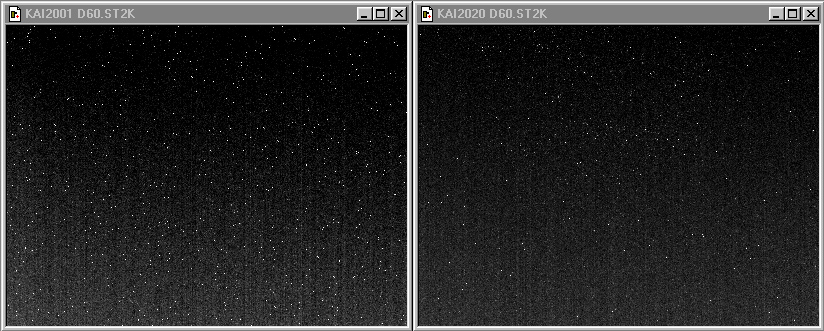 |
Bright points are different from dark current. Bright points are a population of brighter than average pixels. A comparison of one minute dark frames from the KAI-2020M and KAI-2001M illustrates the effect of the ~10X reduction in bright points. The KAI-2020M image is on the right, above. In either case, the bright points are very effectively removed with a filter in CCDOPS and other programs, and whenever a dark frame is subtracted from a light frame. The reduction in bright points does make a cosmetic improvement in unsubtracted images, however. The larger 4 Megapixel KAI-4020M CCD, for example, is very similar in performance to the KAI-2020M, it has virtually the same CCD architecture, read noise and dark current, just more pixels. To see some sample images taken with the 4020M CCD that are not dark subtracted, click here.
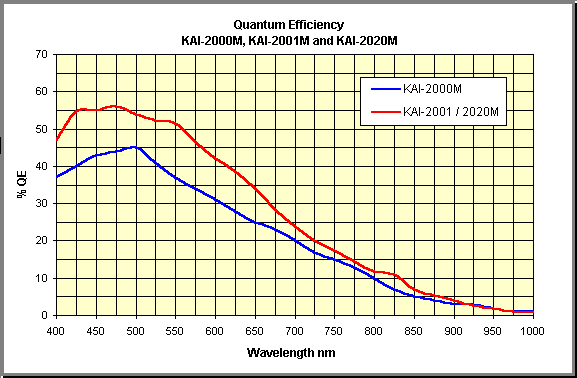 |
The QE of the new KAI-2020M CCD used in the ST-2000M Camera since July 2004 is the same as the ST-2001M, in use since January 2003. It is significantly higher across the visible spectrum than the former KAI-2000M CCD. Typical of the Kodak interline CCDs, this improvement is greater towards the blue and green portion of the spectrum and smaller towards the red and near IR portion of the spectrum. Nevertheless, the camera is quite capable of H-alpha imaging through a narrow band filter. For examples of some H-alpha images with the new CCD click here. The KAI-2001M CCD is used in all ST-2000XM cameras produced in 1993, up until July, 2004 (serial numbers beginning with 20301xxx and ending with 20406xxx). The KAI-2020M CCD is used in cameras beginning with serial numbers 20407xxx.
Improved Autoguiding with a Built-In TC-237H Autoguider
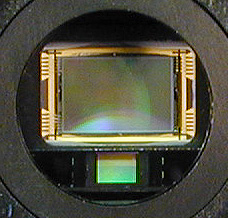 |
Built-in Autoguider |
Array | Pixel Size | CCD Dimension -------- ( Area ) |
Field of View at 80" FL |
Number of Pixels |
| TC-237H CCD | 657 x 495 | 7.4 x 7.4 u | 4.9 x 3.7 mm ----- 18.3 mm2 |
8.2 x 6.2 arcminutes ( 51 arcmin2 ) |
325,215 | |
| TC-211 CCD | 192 x 164 | ~ 15 u | 2.6 x 2.6 mm ----- 6.8 mm2 |
4.5 x 4.5 arcminutes ( 20 arcmin2) |
31,000 |
The TC-237 autoguiding CCD is seen here just below the larger imaging CCD. The TC-237H is the same CCD used in our $1300 ST-237A imaging camera and $2300 STV autoguider. The TC-237H is 2.7X larger than the TC-211 CCD which means there is a more than double the chance you will find suitable guide stars anywhere you happen to be looking without having to hunt. The sample images below demonstrate the difference in field of view.
| Field of View of TC-211 autoguider through an 8" SCT at F/7 30 second unguided image centered on NGC 2903 taken with the TC-211 tracking CCD. 192 x 164 pixels at ~15 microns (unbinned). |
| Field of View of TC-237 autoguider through an 8" SCT at F/7 30 second unguided image of the same area taken with the TC-237 tracking CCD demonstrates the benefit of having 2.7X the field of view: An increase in the number of potential guide stars stars. 328 x 247 pixels at 14.8 microns (binned 2x2). |
In the tracking configuration, the TC-237H CCD will normally be binned 2x2 for increased sensitivity. When binned 2x2 the field of view remains 2.7X that of the TC-211 however as the pixel size is increased to 14.8 microns. The user may also image with the TC-237 CCD in high resolution (unbinned) mode if desired.
Even with a smaller field of view, however, the TC-211 remains an excellent autoguider for the ST-2000ME cameras. With ~15 micron pixels and low noise performance the TC-211 unbinned is more sensitive than the TC-237 in unbinned mode and as sensitive as the TC-237 in binned mode. In tests performed under moderate light pollution with an F/6 telescope, random pointing of the telescope in areas of the sky away from the Milky Way, we found stars on the TC-211 image bright enough to guide on 95% of the time. ThsSky software from Software Bisque automatically generates finder charts showing the correct placement of the guiding CCD field of view relative to the imaging CCD's field of view. Using this tool to plan your nights imaging is a great compliment to the self-guiding cameras.
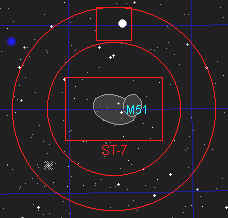 |
Previously, the camera had to be oriented so that the X and Y dimensions of the tracking CCD were aligned with the RA and DEC of the telescope, limiting the possible rotation of the camera to four possible positions around a target at at 90 degree steps. Now, with CCDSoftV5, the autoguiding capability of the TC-211 (and TC-237) is improved so that the camera may be placed in any orientation relative to the telescope's RA and DEC, allowing a full 360 degrees of rotation around a target for easier guide star acquisition. |
Of course, guiding with either the TC-211 or the TC237 tracking CCD means that the imaging CCD spends 100% of its time and quantum efficiency gathering the image. You are not required to compromise for half the quantum efficiency or twice exposure time as you might with other self-guiding designs.
Upgraded Software - TheSky, Version 5, Level II from Software Bisque
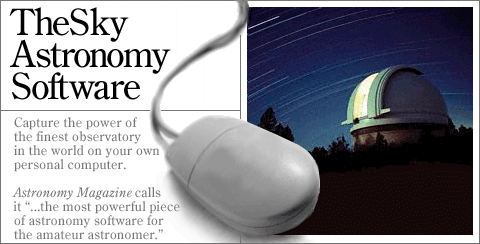
Beginning with all camera shipped in October, 2004, we will include TheSKy version 5, level II, instead of version 4. TheSky version 5, level II, is a complete camera control, image processing, astrometric, star-charting and planetarium software program for the PC. This is a full version of TheSky version 5, complete with manual on CD-ROM. This is a $129 value at no additional cost. Users of TheSky version 5 may upgrade to the latest version 6 at a discount.
New - EquinoX Planetarium Software with SBIG Camera Control for Mac OS X by Microprojects
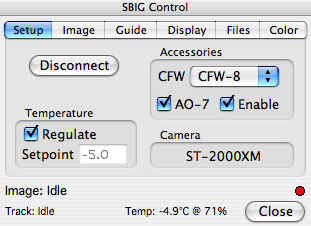 |
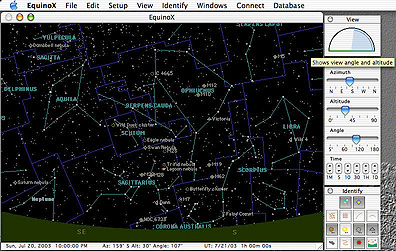 |
If you use an Apple Macintosh G3, G4 or G5, with OS X 10.2 or later, Equinox 5.1 can control SBIG USB and Ethernet cameras. SBIG will send a free copy of Equinox upon request to any new SBIG camera purchaser with proof of purchase. Send us a copy of your invloce with camera serial number. Click on the links below to the Microprojects web site for more information:
SBIG camera control features and screen shots
Find out more about Equinox planetarium features
Deluxe Carrying and Storage Case
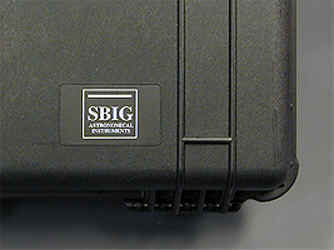 |
The ST-2000XM and ST-2000XCM models now include a high quality carrying and storage case made for SBIG by Pelican. This deluxe carrying case is dust proof, water proof, crush proof and carries a lifetime guarantee from the manufacturer. The custom cut foam securely holds the camera and power supply with additional spots for accessories, cables, etc. There is even room for the camera with filter wheel and AO-7 attached.
Upgrades
Upgrades to a TC-237H autoguiding CCD are available to all ST-2000XM owners for
$395. Upgrades to the new KAI-2020M imaging CCD are available for $995.
Upgrades from TheSky version 5 to the latest version 6 are available from Software Bisque for $99 (use your camera serial number as
the serial number for an on-line upgrade). The custom Pelican carrying case is
available for $149.
Complete Systems
As of November, 2004, each new ST-2000XM camera system INCLUDES at no additional cost:
More ST-2000XM links:
ST-2000XM Sample Image Page ST-2000XM On Line Product Catalog Page with Specifications Price List
Price and specifications are subject to change without notice.
Revised: January 07, 2005 06:17:13 PM.
Copyright © 2004 Santa Barbara Instrument Group, Inc. All rights reserved.
Please report any problems with this page directly to the Webmaster